Grade 6 Math Word Problems: Tips, Tricks, and Answers
Do you want to stimulate your 6th grader’s creative thinking skills? Then, enjoy this brilliant math article. In this comprehensive guide, we will provide you with a treasure trove of fun solving strategies, tips, tricks, and answers to tackle those tricky grade 6 math word problems that have been confusing your students for some time now.
-
In this page, you will discover why math word problems are important for 6th-graders and simple methods of breaking down complex word problems into manageable steps.
Nevertheless, we will introduce you to Mathskills4kids.com, an outstanding website with thousands of common types of grade 6 math word problems and a step-by-step approach to solving them. Interestingly, we will illustrate how to use diagrams and models to solve math word problems efficiently.
Learn to love Grade 6 Math word problems with these worksheets and answers
Hello and welcome to Grade 6 Math word problems worksheets and answers, where your 6th Grade students will learn to love and solve math problems and activities at all times.
We understand that word problems can often frustrate students, as they require a solid understanding of mathematical concepts and the ability to interpret and apply them to real-life situations. That's why we have compiled a collection of proven strategies and techniques to empower your students to approach word problems confidently and accurately.
From understanding problem-solving strategies to breaking down complex questions into manageable steps, this guide will equip you with the knowledge and resources to make math word problems a breeze. So, let's dive in and unlock the secrets to conquering grade 6 math word problems together!
-
BROWSE THE WEBSITE
-
DOWNLOAD FREE WORKSHEETS
-
-
GRADE 6 MATH TOPICS
- Whole numbers
- Multiplication
- Division
- Exponents and square roots
- Number theory
- Decimals
- Add & subtract decimals
- Multiply & divide decimals
- Fractions & mixed numbers
- Add & subtract fractions
- Multiply fractions
- Divide fractions
- Integers
- Operations with integers
- Mixed operations
- Rational numbers
- Problems solving
- Ratio & proportions
- Percentages
- Measuring units
- Money math
- Consumer math
- Telling time
- Coordinate graph
- Algebraic expressions
- One step equations
- Solve & graph inequalities
- Two-step equations
- 2D Geometry
- Symmetry & transformation
- 3D Shapes
- Geometry measurement
- Data and Graphs
- Statistics
- Probability
-
-
Estimate to solve word problems
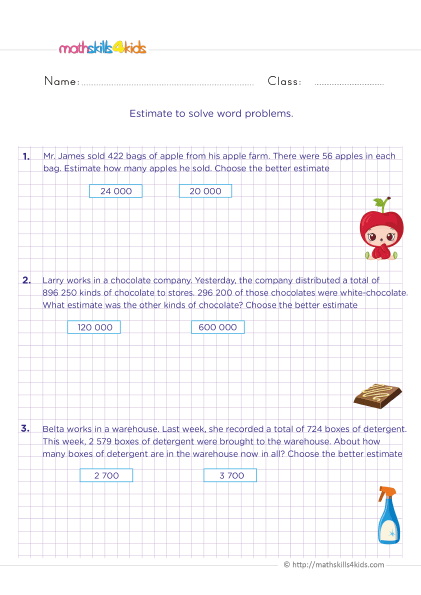 Print it...
Print it...
-
Solving multi step word problems exercises with answers
 Print it...
Print it...
-
Identifying reasonable answers for multi-step word problems
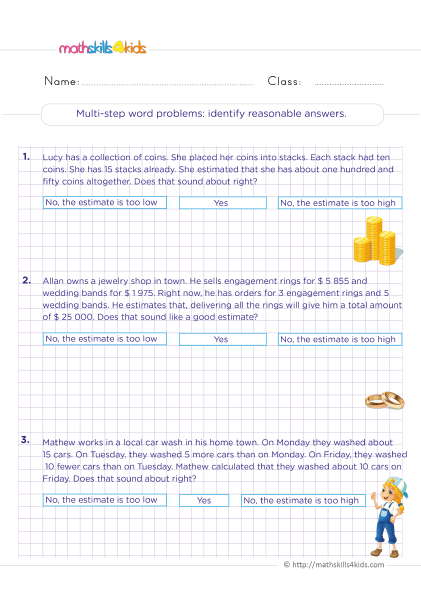 Print it...
Print it...
-
Word problems with extra or missing information
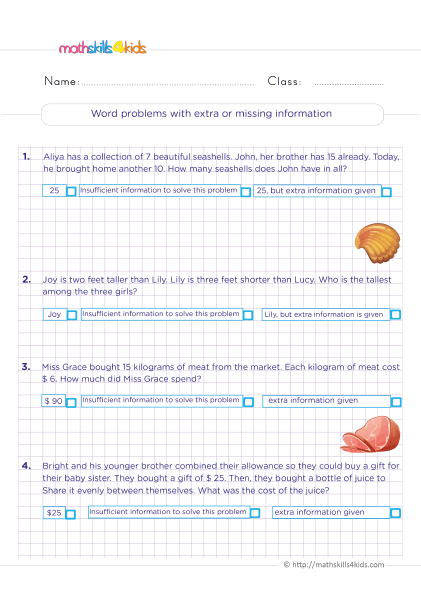 Print it...
Print it...
-
Guess and check word problems
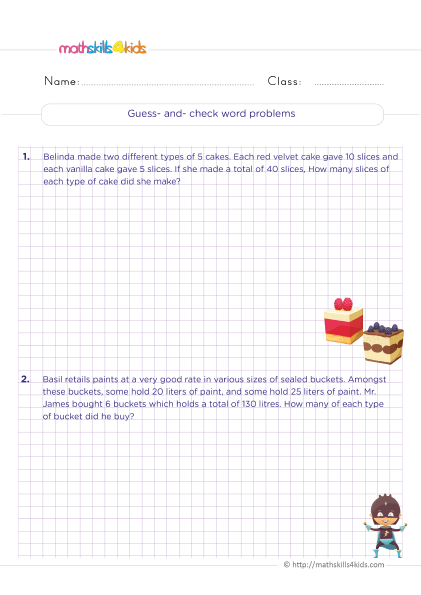 Print it...
Print it...
-
Distance word problems with different directions
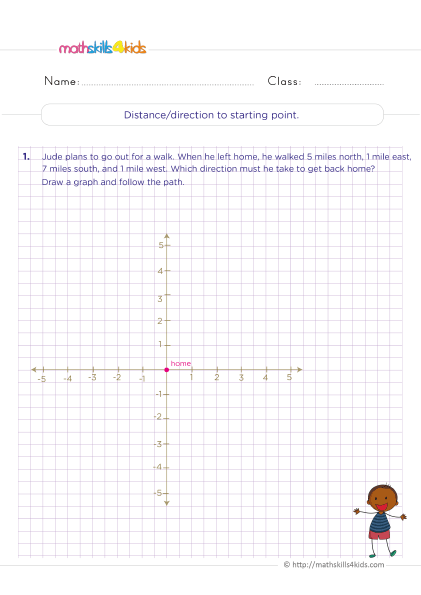 Print it...
Print it...
-
Estimate to solve word problems
-
Buying is supporting us!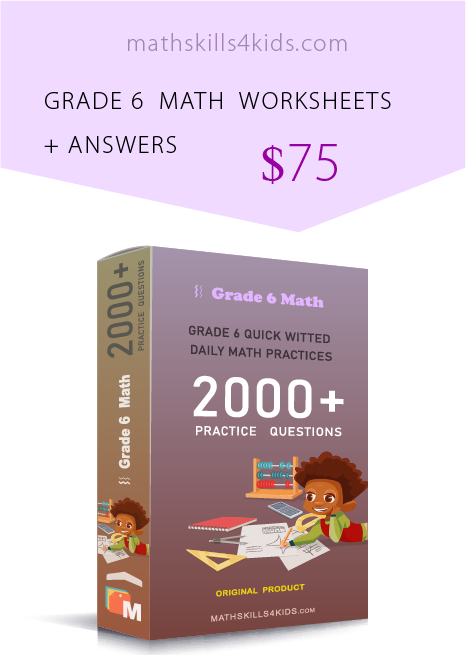
Buy Now...
-
-
Why are math word problems important for 6th-graders?
Math word problems are about more than just doing calculations. They are also about applying your math knowledge to real-world situations. Math word problems are important for 6th graders because they help them to:
- Learn how to use different math concepts and skills in various contexts
- Develop their logical thinking and reasoning abilities
- Enhance their communication and literacy skills
- Prepare them for standardized tests and future math courses
Math word problems also make math more exciting and relevant. They show us how math can solve everyday problems and challenges. They also expose us to different topics and scenarios we may not encounter in our regular math lessons.
-
Strategies for solving Grade 6 math word problems
Solving Grade 6 math word problems can be intimidating, especially involving multiple steps or operations. But don't worry. Some general strategies will help your students confidently approach any word problem. Here are some of them:
- Please encourage them to read the problem carefully and identify the given information, the unknowns, and the question.
- They should rewrite the problem in their own words or summarize it in a sentence.
- Let them choose a suitable method or strategy to solve the problem. Some standard methods are guessing and checking, making a table or chart, drawing a picture or diagram, using a formula or equation, working backward, or using logical reasoning.
- They must show their work and explain each step clearly. Use appropriate units, labels, symbols, and terms.
- Lastly, tell them to check their answer by plugging it back into the problem or using a different method. Ensure their answer makes sense and answers the question.
-
Breaking down complex word problems into manageable steps
Some word problems may seem too complex or confusing at first glance. They may have too much information, too many steps, or too many operations. In such cases, breaking down the problem into smaller and simpler parts is helpful. Here are some tips on how to do that:
- Look for keywords or phrases that indicate what operation or concept is involved in each part of the problem. For example, words like "total," "sum," "add," or "plus" indicate addition.
Words like "difference," "subtract," "take away," or "minus" indicate subtraction.
Words like "product," "multiply," "times," or "of" indicate multiplication.
Words like "quotient," "divide," "per," or "out of" indicate division.
Words like "ratio," "fraction," "percent," or "part" indicate fractions or decimals.
Words like "equal," "same as," or "is" indicate equations.
Words like "more than,” “less than," "greater than," or "smaller than" indicate inequalities.
Words like "average," "mean," or "median" indicate statistics.
Words like "area," "perimeter," "volume," or "surface area" indicate geometry, etc.
- Use parentheses, brackets, or other symbols to group the parts of the problem that belong together. For example, if the problem says:
- John has 12 apples, and Mary has 8 apples. They want to share their apples equally among themselves and their two friends. How many apples will each person get?
You can rewrite it as:
- (John has 12 apples) + (Mary has 8 apples) = (total number of apples) / (4 people) = (number of apples per person)
- Solve each part of the problem separately and write down the intermediate results. For example, using the previous problem:
- (John has 12 apples) + (Mary has 8 apples) = (total number of apples)
- 12 + 8 = 20
- (total number of apples) / (4 people) = (number of apples per person)
- 20 / 4 = 5
This way, you can keep track of your work and avoid making mistakes.
- Combine the intermediate results to get the final answer. For example, using the previous problem:
- (number of apples per person) = 5
This way, you can answer the question and check your answer.
This way, you can see the structure of the problem more clearly and focus on one part at a time.
- Look for keywords or phrases that indicate what operation or concept is involved in each part of the problem. For example, words like "total," "sum," "add," or "plus" indicate addition.
-
Common types of grade 6 math word problems
There are many types of word problems that you may encounter in grade 6 math. Some of the most common ones found on Mathskills4kids.com are:
- Ratio and proportion problems: These problems involve finding the relationship between two quantities with the same unit or measure. For example, if 12 pencils cost $3, how much do 20 pencils cost?
- Percent problems: These problems involve finding the part, whole, or percent of a quantity. For example, if 30% of a class is boys, and there are 24 students, how many boys are there?
- Fraction problems: These problems involve adding, subtracting, multiplying, or dividing fractions. For example, how much pizza do you have left if you have 2/3 of a pizza and eat 1/4?
- Decimal problems: These problems involve adding, subtracting, multiplying, or dividing decimals. For example, if you buy a shirt for $12.50 and a pair of jeans for $24.75, how much change do you get from $50?
- Measurement problems: These problems involve converting between different units of measurement or finding the perimeter, area, or volume of shapes. For example, if a rectangle has a length of 15 cm and a width of 10 cm, what is its area in square meters?
- Algebra problems: These problems involve finding the value of an unknown variable or expression. For example, if x + 5 = 13, what is the value of x?
-
A step-by-step approach to solving different types of word problems
No matter what type of word problem your 6th graders are faced with, they can use the following steps to solve it:
- They should read the problem carefully and identify the given information and the question.
- They must choose a variable to represent the unknown quantity and write an equation or expression that relates the given information and the question.
- They can now solve the equation or expression and find the variable's value.
- They can check their answer by plugging it back into the equation or expression to see if it makes sense.
- They can now write their answer in complete sentences and include the appropriate units.
-
Using diagrams and models to solve math word problems
Sometimes, it can be helpful to use diagrams and models to visualize the problem and make it easier to solve. Some examples of diagrams and models for solving math word problems are:
- Tape diagrams: These are horizontal or vertical bars showing the relationship between two quantities. For example, you can use a tape diagram to show how much money each person gets when $60 is shared equally among 4 people.
- Number lines: These horizontal lines show numbers and their relative positions. For example, you can use a number line to show how to add or subtract fractions with different denominators.
- Tables: These are grids that show data in rows and columns. For example, you can use a table to show how to find equivalent ratios or fractions.
- Charts: These are graphical representations of data using bars, circles, lines, or other shapes. For example, you can use a chart to show how to find the percent of a quantity or compare different quantities.
- Drawings: These are sketches or illustrations that show shapes or objects. For example, you can use a drawing to show how to find a shape's perimeter, area, or volume.
-
Providing answers and explanations to sample Mathskills4kids’ Grade 6 math word problems
Here are some sample Grade 6 math word problems with answers and explanations available at Mathskills4kids.com:
- A cookie recipe calls for 2 cups of flour for every 3 cups of sugar. How much flour is needed for 9 cups of sugar?
Answer: 6 cups of flour
Explanation: This is a ratio problem. We can use a tape diagram to show the relationship between flour and sugar.
Flour →|<---2 cups--->|<---2 cups--->|<---2 cups---> = 6
Sugar→|<---3 cups--->|<---3 cups--->|<---3 cups---> = 9
We can see that for every 3 cups of sugar, we need 2 cups of flour. So, for 9 cups of sugar, we need 6 cups of flour.
- A shirt is on sale for 40% off its original price of $25. What is the sale price of the shirt?
Answer: $15
Explanation: This is a percent problem. We can use a formula to find the sale price of the shirt.
Sale price = Original price - Discount
Discount = Percent off x Original price
We know the percent off is 40%, and the original price is $25. So, we can plug these values into the formula and solve for the sale price.
Discount = 40% x $25
Discount = 0.4 x $25
Discount = $10
Sale price = $25 - $10
Sale price = $15
- A cookie recipe calls for 2 cups of flour for every 3 cups of sugar. How much flour is needed for 9 cups of sugar?
-
Tips for improving problem-solving skills in Grade 6 math
Here are some tips that can help students improve their problem-solving skills in grade 6 math:
- Please encourage them to practice regularly and try different types of word problems.
- They should review the concepts and skills they have learned and apply them to new situations.
- They can use different strategies and methods to solve word problems and compare their results.
- Let them ask for help from the teacher, parents, or peers if they get stuck or confused.
- They should learn from their mistakes and try to avoid them in the future.
Bonus: additional resources to reinforce Grade 6 math problem skills
If you want to enhance your student's Grade 6 math word problem skills, or if you need some extra help, here are some additional and useful web links that you can check out:
- Math Playground: This website has a lot of fun and interactive games that let 6th graders practice different types of math word problems, such as fractions, decimals, ratios, proportions, and more. They can also watch videos explaining how to solve some problems. https://www.mathplayground.com/wordproblems.html.
- Khan Academy: This website has many videos and exercises covering various topics in Grade 6 math, including word problems. Students can learn at their own pace and track their progress. https://www.khanacademy.org/math/cc-sixth-grade-math.
- IXL: This website has many practice questions aligned with the Common Core standards for Grade 6 math. Students can choose from different categories of word problems, such as expressions and equations, geometry, statistics, and more. They can also get instant feedback and explanations for their answers. https://www.ixl.com/math/grade-6.
- Math Goodies: This website has a lot of worksheets and lessons that teach 6th graders how to solve different types of word problems, such as percent, ratio, proportion, and more. They can also find tips and tricks for solving word problems faster and easier. https://www.mathgoodies.com/math-mammoth/worksheets/pdf/grade_6_word_problems.pdf.
-
-
Thank you for sharing the links of MathSkills4Kids.com with your loved ones. Your choice is greatly appreciated.
Conclusion
Math word problems can be challenging for many 6th-graders, but they are also important for developing their mathematical thinking and reasoning skills.
Using the strategies and steps we discussed in this article, your student's ability to solve different types of word problems in Grade 6 math can be improved.
You can also use the diagrams and models we have shown you to help your students visualize the problem and find the solution. Encourage them to practice as much as possible, and they must not be afraid to ask for help if needed.
You can also use the web links that we have provided to reinforce your student’s learning and have fun with math. We hope this article has helped your 6th-grade students feel more confident and prepared for tackling Grade 6 math word problems.
Happy problem-solving!
